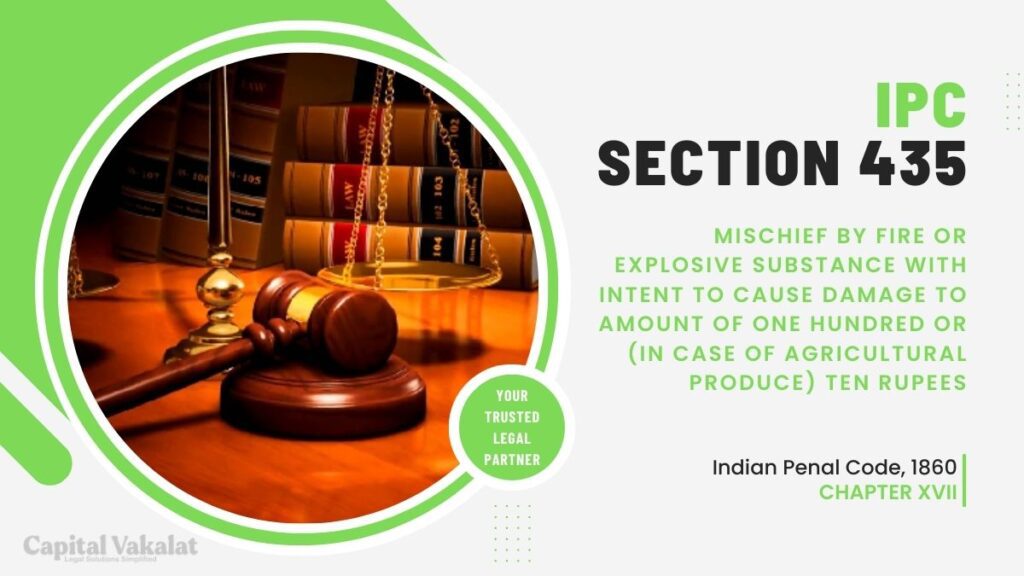Section 435 of the Indian Penal Code (IPC) addresses a critical aspect of criminal law, focusing on mischief by fire or explosive substance with the intent to cause damage.

This article delves into the intricacies of Section 435 IPC, examining its legal dimensions, the significance of intent, penalties, and specific considerations regarding agricultural produce.
Understanding Section 435 IPC
The legal text of Section 435 IPC provides a framework for addressing offenses related to mischief by fire or explosive substance. Understanding the nuanced interpretation of this section is crucial for both legal professionals and the general public. The degree of damage caused plays a pivotal role in determining the severity of the offense.
Intent and Its Significance
Establishing intent is a fundamental aspect of criminal law, and Section 435 IPC is no exception. This section explicitly considers the intent behind causing damage through fire or explosive substances. The article explores how the legal system discerns intent, citing relevant cases to underscore its significance in mischief offenses.
Penalties and Punishments
Individuals found guilty under Section 435 IPC face legal consequences commensurate with the extent of the damage caused. This section of the article outlines the penalties and punishments associated with violating this provision, shedding light on how the legal system differentiates offenses based on the degree of damage inflicted.
Agricultural Produce and Special Considerations
Section 435 IPC extends its purview to offenses involving agricultural produce. The article delves into the specifics of these cases, highlighting the unique considerations in assessing damage to agricultural resources. Legal implications and potential consequences for those found guilty of agricultural mischief are explored in detail.
Historical Context and Amendments
An exploration of the historical context and amendments to Section 435 IPC provides insights into the evolution of this legal provision. The article traces the changes made over the years, emphasizing notable case studies that have influenced the interpretation and application of this section.
Challenges in Prosecution
Prosecuting offenses under Section 435 IPC presents its own set of challenges. Gathering evidence, establishing guilt, and defending against allegations require careful legal strategy. The article examines the difficulties faced in prosecuting mischief cases and the defenses that can be employed to counter such charges.
Public Awareness and Prevention
Public awareness of Section 435 IPC is crucial for fostering responsible conduct. The article discusses the importance of educating the public about the legal implications of mischief offenses, outlines preventive measures, and emphasizes the role of community involvement in reporting suspicious activities.
Impact on Insurance Claims
The article sheds light on the impact of mischief-related damages on insurance claims. It explores the coverage provided for such incidents, factors considered by insurance companies, and the legal implications involved in processing claims related to offenses under Section 435 IPC.
Conclusion
In conclusion, Section 435 IPC plays a vital role in addressing offenses involving mischief by fire or explosive substance. This article has explored the legal nuances, highlighted the significance of intent, discussed penalties, and delved into specific considerations for offenses related to agricultural produce. Balancing justice and rehabilitation, this section of the law aims to deter such acts while ensuring fair legal proceedings.
Frequently Asked Questions
How does the legal system differentiate between degrees of damage in mischief cases?
The legal system considers the extent of damage inflicted, categorizing offenses under Section 435 IPC based on the severity of the harm caused.
Are there specific defenses against allegations of mischief under Section 435 IPC?
Defenses against allegations can vary but may include lack of intent, insufficient evidence, or establishing an alibi.
What role does public awareness play in preventing mischief offenses?
Public awareness is essential in preventing mischief offenses as an informed community can contribute to early detection and reporting.
How have historical amendments influenced the interpretation of Section 435 IPC?
Historical amendments have shaped the interpretation of Section 435 IPC, reflecting changes in societal norms and legal perspectives over time.